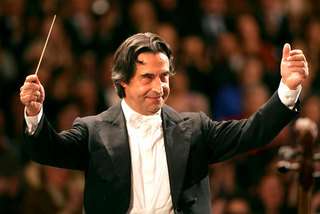|
Back
Vintage Muti New York
Avery Fisher Hall
11/27/2009 - & November 28*, 2009
Arnold Schoenberg: Verklaerte Nacht
Ludwig van Beethoven: Symphony No. 3
New York Philharmonic, Riccardo Muti (conductor)

When Arthur Nikisch died in 1922, the Gewandhaus Orchestra auditioned several conductors to take his post. One of the lesser known of these, Wilhelm Furtwängler, chose to conduct the second movement of the “Eroica” as a funereal tribute. The young lion asked the audience to stand through the entire reading, thus magnifying their shared grief. He got the job.
I thought of this incident often on Saturday as Riccardo Muti led the New York Philharmonic in a very good performance of the entire work. What a pleasure to hear a Beethoven slow movement played slowly! This orchestra always sounds better under this particular guest – the man who could have been king – and really sounds fresh since changing to an antiphonal platform positioning (thank you, Mr. Gilbert). This was an intense performance of the funeral march and one that caught that special Beethovenian balance of tragedy between the death of an emperor and that of a regular individual.
The remainder of this rendition was quite lively, satisfactory in every way. The orchestra was neither elephantine nor fashionably but anemically reduced, while the experience as a whole was vintage Muti. Maestro coaxed a cantabile line from his troops, even in sections that in other hands would have sounded much more strident and Germanic. Muti also stayed in character throughout, turning to glare at the audience at the faintest appearance of a cough, but isn’t this superciliousness all part of the show?
Along with arguably the first great work of the nineteenth century, the Phil chose to feature the last great work of that partuclar hundred years, as a hand-picked sextet performed the original version of Arnold Schoenberg’s Transfigured Night. Personally, I love this format of a chamber work followed by an intermission followed by a large symphony, but few, if any, orchestras other than the Phil utilize it on a regular basis.
Sadly, the small group, which featured the “A” team of the first chair violinist, violist and cellist of the ensemble as a whole, gave a rather restrained and buttoned-up reading, missing virtually all of the underlying passion (and there is much of that) of the piece in favor of a gingerly “unobjectionable” interpretation. Further, Glenn Dicterow’s slick tone made one think more of the Hollywood Schoenberg than the Viennese.
Fred Kirshnit
|